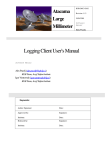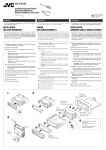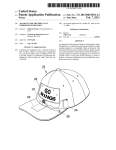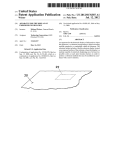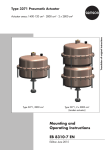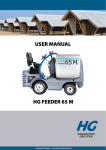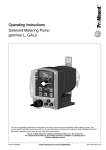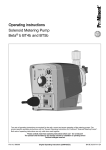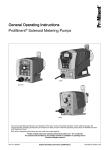Download Delta 36-540 Instruction manual
Transcript
(Model 36-540 & Model 36-545 W/Stand) PART NO. 899974-0010 Copyright © 2000 Delta Machinery To learn more about DELTA MACHINERY visit our website at: www.deltamachinery.com. For Parts, Service, Warranty or other Assistance, please call ESPAÑOL: PÁGINA 23 1-888-848-5175 (In Canada call 1-800-463-3582). INSTRUCTION MANUAL 10" Motorized Bench Saw SAFETY RULES Woodworking can be dangerous if safe and proper operating procedures are not followed. As with all machinery, there are certain hazards involved with the operation of the product. Using the machine with respect and caution will considerably lessen the possibility of personal injury. However, if normal safety precautions are overlooked or ignored, personal injury to the operator may result. Safety equipment such as guards, push sticks, hold-downs, featherboards, goggles, dust masks and hearing protection can reduce your potential for injury. But even the best guard won’t make up for poor judgment, carelessness or inattention. Always use common sense and exercise caution in the workshop. If a procedure feels dangerous, don’t try it. Figure out an alternative procedure that feels safer. REMEMBER: Your personal safety is your responsibility. This machine was designed for certain applications only. Delta Machinery strongly recommends that this machine not be modified and/or used for any application other than that for which it was designed. If you have any questions relative to a particular application, DO NOT use the machine until you have first contacted Delta to determine if it can or should be performed on the product. Technical Service Manager Delta Machinery 4825 Highway 45 North Jackson, TN 38305 (IN CANADA: 505 SOUTHGATE DRIVE, GUELPH, ONTARIO N1H 6M7) WARNING: FAILURE TO FOLLOW THESE RULES MAY RESULT IN SERIOUS PERSONAL INJURY 1. FOR YOUR OWN SAFETY, READ INSTRUCTION 15. MAINTAIN TOOLS IN TOP CONDITION. Keep tools MANUAL BEFORE OPERATING THE TOOL. Learn the sharp and clean for best and safest performance. Follow tool’s application and limitations as well as the specific instructions for lubricating and changing accessories. hazards peculiar to it. 16. DISCONNECT TOOLS before servicing and when 2. KEEP GUARDS IN PLACE and in working order. changing accessories such as blades, bits, cutters, etc. 3. ALWAYS WEAR EYE PROTECTION. 17. USE RECOMMENDED ACCESSORIES. The use of accessories and attachments not recommended by Delta 4. REMOVE ADJUSTING KEYS AND WRENCHES. may cause hazards or risk of injury to persons. Form habit of checking to see that keys and adjusting wrenches are removed from tool before turning it “on”. 18. REDUCE THE RISK OF UNINTENTIONAL STARTING. Make sure switch is in “OFF” position before plugging 5. KEEP WORK AREA CLEAN. Cluttered areas and in power cord. benches invite accidents. 19. NEVER STAND ON TOOL. Serious injury could occur 6. DON’T USE IN DANGEROUS ENVIRONMENT. Don’t if the tool is tipped or if the cutting tool is accidentally conuse power tools in damp or wet locations, or expose them tacted. to rain. Keep work area well-lighted. 20. CHECK DAMAGED PARTS. Before further use of the 7. KEEP CHILDREN AND VISITORS AWAY. All children tool, a guard or other part that is damaged should be careand visitors should be kept a safe distance from work area. fully checked to ensure that it will operate properly and per8. MAKE WORKSHOP CHILDPROOF – with padlocks, form its intended function – check for alignment of moving master switches, or by removing starter keys. parts, binding of moving parts, breakage of parts, mount9. DON’T FORCE TOOL. It will do the job better and be ing, and any other conditions that may affect its operation. safer at the rate for which it was designed. A guard or other part that is damaged should be properly repaired or replaced. 10. USE RIGHT TOOL. Don’t force tool or attachment to do a job for which it was not designed. 21. DIRECTION OF FEED. Feed work into a blade or cutter against the direction of rotation of the blade or cutter 11. WEAR PROPER APPAREL. No loose clothing, gloves, only. neckties, rings, bracelets, or other jewelry to get caught in moving parts. Nonslip footwear is recommended. Wear 22. NEVER LEAVE TOOL RUNNING UNATTENDED. TURN protective hair covering to contain long hair. POWER OFF. Don’t leave tool until it comes to a complete stop. 12. ALWAYS USE SAFETY GLASSES. Wear safety glasses. Everyday eyeglasses only have impact resistant lens23. DRUGS, ALCOHOL, MEDICATION. Do not operate es; they are not safety glasses. Also use face or dust tool while under the influence of drugs, alcohol or any medmask if cutting operation is dusty. These safety glasses ication. must conform to ANSI Z87.1 requirements. Note: 24. MAKE SURE TOOL IS DISCONNECTED FROM Approved glasses have Z87 printed or stamped on POWER SUPPLY while motor is being mounted, connectthem. ed or reconnected. 13. SECURE WORK. Use clamps or a vise to hold work 25. THE DUST GENERATED by certain woods and wood when practical. It’s safer than using your hand and frees products can be injurious to your health. Always operate both hands to operate tool. machinery in well ventilated areas and provide for proper 14. DON’T OVERREACH. Keep proper footing and baldust removal. Use wood dust collection systems whenever ance at all times. 2 possible. 26. WHEN THE TOOL IS NOT IN USE the switch should be locked in the "OFF" position to prevent unauthorized use. masonry products, and · arsenic and chromium from chemically-treated lumber. Your risk from these exposures varies, depending on how often you do this type of work. To reduce your exposure to these chemicals: work in a well ventilated area, and work with approved safety equipment, such as those dust masks that are specially designed to filter out microscopic particles. 27. WARNING: SOME DUST CREATED BY POWER SANDING, SAWING, GRINDING, DRILLING, AND OTHER CONSTRUCTION ACTIVITIES contains chemicals known to cause cancer, birth defects or other reproductive harm. Some examples of these chemicals are: · lead from lead-based paints, · crystalline silica from bricks and cement and other SAVE THESE INSTRUCTIONS ADDITIONAL SAFETY RULES FOR CIRCULAR SAWS 14. DIRECTION OF FEED. Feed work into blade or cutter against the direction or rotation of the blade or cutter only. 15. DO NOT feed the material too fast while cutting. Feed the material only fast enough so that the blade will cut. 16. NEVER attempt to free a stalled saw blade without first turning the saw “OFF.” 17. NEVER start the saw with the workpiece pressed against the blade. 18. NEVER turn the saw “ON” before clearing the table of all objects (tools, scraps of wood, etc.). 19. ALWAYS STOP the saw before removing scrap pieces from the table. 20. NEVER perform layout, assembly or set-up work on the table while the saw is operating. 21. PROVIDE adequate support to the rear and sides of the saw table for wide or long workpieces. 22. NEVER use solvents to clean plastic parts. Solvents could possibly dissolve or otherwise damage the material. Only a soft damp cloth should be used to clean plastic parts. 23. SHOULD any part of your circular saw be missing, damaged, or fail in any way, or any electrical components fail to perform properly, shut off switch and remove plug from power supply outlet. Replace missing, damaged or failed parts before resuming operation. 24. USE only 10" diameter saw blades rated for 4600 RPM or higher with 5/8" arbor holes. 25. THE USE of attachments and accessories not recommended by Delta may result in the risk of injuries. 26. ADDITIONAL INFORMATION regarding the safe and proper operation of this product is available from the National Safety Council, 1121 Spring Lake Drive, Itasca, IL 60143-3201, in the Accident Prevention Manual for Industrial Operations and also in the Safety Data Sheets provided by the NSC. Please also refer to the American National Standards Institute ANSI 01.1 Safety Requirements for Woodworking Machinery and the U.S. Department of Labor OSHA 1910.213 Regulations. 27. SAVE THESE INSTRUCTIONS. Refer to them often and use them to instruct others. 1. DO NOT operate your saw until it is completely assembled and installed according to the instructions. 2. IF YOU ARE NOT thoroughly familiar with the operation of circular saws, obtain advice from your supervisor, instructor, or other qualified person. 3. ALWAYS use blade guard, splitter and anti-kickback fingers for every operation for which it can be used, including all thru sawing. 4. ALWAYS hold the work firmly against the miter gage or fence. 5. NEVER use the fence as a cut-off gage when cross-cutting. 6. MOVE the rip fence out of the way when cross-cutting. 7. NEVER perform any operation “free-hand” which means using your hands to support or guide the workpiece. Always use either the fence or miter gage to position and guide the work. 8. ALWAYS use a push stick for ripping narrow stock. Refer to ripping applications in instruction manual where the push stick is covered in detail. 9. AVOID KICKBACKS (work thrown back toward you) by: A. Keeping blade sharp. B. Keeping rip fence parallel to the saw blade. C. Keeping splitter and anti-kickback fingers and guard in place and operating. D. Not releasing the work before it is pushed all the way past the saw blade. E. Not ripping work that is twisted or warped or does not have a straight edge to guide along the fence. 10. AVOID awkward operations and hand positions where a sudden slip could cause your hand to move into the cutting tool. 11. ALWAYS keep hands and fingers away from the blade. 12. NEVER stand or have any part of your body in line with the path of the saw blade. 13. NEVER reach behind or over the cutting tool with either hand for any reason. 3 UNPACKING Your new saw is shipped complete in one container. Carefully unpack the saw and all loose items from the shipping container. Fig. 2, illustrates the saw removed from the container and Fig. 2A, illustrates all the loose items packed with the saw. Fig. 2 5 4 6 17 14 22 1 16 15 20 19 13 12 10 2 3 8 27 18 25 24 21 11 28 23 7 26 9 29 Fig. 2A 1- Rip Fence 2- M8 Hex Nut for Rip Fence 3- Locking Handle for Rip Fence 4- Splitter and Guard Assembly 5- Miter Gage 6- Blade Raising and Lowering Handwheel 7- M6 x 12mm Flat Head Screw for Mounting Blade Raising and Lowering Handwheel 8- Handle for Blade Raising and Lowering Handwheel 9- M6 x 55mm Cheese Head Screw for Mounting Handwheel Handle 10- 2-1/4" Long Hex Head Screw for Mounting Splitter Bracket 11- 1/4" Internal Tooth Lockwasher for Mounting Splitter Bracket 12- Flat Washer for Mounting Splitter Bracket 13- 1/4" External Tooth Lockwasher for Mounting Splitter Bracket 14- Splitter Bracket 15- 1/4" Lockwasher for Splitter Bracket 16- 1/2" Hex Head Screw for Splitter Bracket 17- Splitter Support Bracket 18- 20mm Hex Head Screw for Mounting Splitter Support Bracket 19- 1/4" External Tooth Washer for Mounting Splitter Support Bracket (2) 20- M6.4 Flat Washer for Mounting Splitter Support Bracket (2) 21- M6 Wing Nut for Mounting Splitter Support Bracket 22- Miter Gage Holder 23- Spring Clip for Miter Gage Holder 24- M4 Hex Nut for Miter Gage Holder 25- 3/16" External Tooth Lockwasher for Miter Gage Holder 26- 10mm Pan Head Screw for Miter Gage Holder 27- 6.4mm Flat Washer for Mounting Miter Gage Holder (4) 28- M6 x 25mm Pan Head Screws for Mounting Miter Gage Holder (4) 29- Wrenches for Blade Changing 4 30 39 36 37 32 34 35 33 31 Fig. 4 30 - Leg (4) 31 - 3/8” Flat Washer for Mounting Saw to Stand & for Assembling Stand (24) 32 - Foot (4) 33 - M8 Hex Nut for Mounting Saw to Stand & for Assembling Stand (20) 34 - M8 x 40mm Hex Screw for Mounting Saw to Stand (4) 35 - M8 x 20mm Carriage Bolts for Assembling Stand (16) 36 - 18-1/2” Top Front and Rear Brackets (2) 37 - 17” Top Side Brackets (2) 38 - 22” Bottom Front and Rear Brackets (2) 39 - 20-3/8” Bottom Side Brackets (2) 5 38 ASSEMBLY INSTRUCTIONS ASSEMBLING BLADE RAISING AND LOWERING HANDWHEEL A 1. Insert M6 x 55 screw (9) Fig. 2A, through handle (E) Fig. 3A, and assemble handle (E) to handwheel (A) by threading screw (D) clockwise into handwheel. E D Fig. 3A 2. Fig. 3B, illustrates the handle (E) assembled to handwheel (A). A E Fig. 3B 3. Assemble handwheel (A) Fig. 4, to shaft (B) making sure the flat on inside of handwheel lines up with flat on shaft. B A Fig. 4 4. Fasten handwheel (A) Fig. 5, to shaft using a M6 x 12mm screw (7) Fig. 2A. A 7 6 Fig. 5 ASSEMBLING BLADE GUARD AND SPLITTER ASSEMBLY A B 1. DISCONNECT THE SAW FROM THE POWER SOURCE. 2. IMPORTANT: THE BLADE GUARD AND SPLITTER ASSEMBLY MUST BE PROPERLY ALIGNED TO THE SAW BLADE IN ORDER TO PREVENT KICKBACK. C 3. Position the blade 90 degrees to the table and lock in place. Fig. 6 4. Fasten the splitter support bracket (A) Fig. 9, to splitter bracket (B) using two 1/2 inch-long screws (C) which were removed from splitter bracket (B) earlier, and two 1/4 inch external tooth lockwashers as shown. NOTE: Do not completely tighten screws (C) at this time. R P 5. Locate the 2-1/4" long hex head screw (G) Fig. 7, and assemble the internal tooth lockwasher (O), flat washer (P) and external tooth lockwasher (R) onto screw (G). O G 6. Position recessed end (E) Fig. 8, of splitter bracket (B) against end of pivot rod (F) and fasten in place using the 2-1/4" long hex head screw (G) Fig. 9, internal tooth lockwasher, flat washer and external tooth lockwasher which were assembled to screw (G) in STEP 5. NOTE: Do not completely tighten screws (C) at this time. Fig. 7 7. Position the splitter (H) Fig. 10, on the splitter support bracket as shown, making certain the two protrusions (K) on the splitter support bracket are inside the slot of splitter (H). F E B Fig. 8 H G K Fig. 9 Fig. 10 7 8. Assemble splitter (H) Fig. 11, to splitter support bracket (B) as shown using 3/4 inch-long hex head screw, external tooth washer, and flat washer (L). L H B 9. Fasten splitter (H) Fig. 12, to splitter support bracket using flat washer, external tooth lockwasher and wing nut (M). NOTE: Before tightening wing nut (M) make certain there is at least a 1/8" gap between the bottom edge of splitter (N) and top surface of table (P) and that protrusions (K) Fig. 12, are inside the slot of splitter assembly (H). Fig. 11 10. Using a straight edge, check to see if the splitter (H) Fig. 12A, is aligned with the saw blade (R). If an adjustment is necessary, the splitter (H) can be moved left or right and rotated. H 11. When you are certain the splitter is properly aligned with the saw blade, tighten the two screws (C) Fig. 12B, that fasten the splitter support bracket to the splitter bracket and tighten screw (G) that fastens the splitter bracket to the pivot rod. P K M N Fig. 12 R G H C Fig. 12A Fig. 12B MITER GAGE The miter gage is shipped completely assembled and is supplied with a T-slot miter gage bar (A) Fig. 13, that is inserted into either one of the two T-slotted miter gage grooves located in the table top, as shown. The T-slot miter gage prevents the miter gage from falling when it is extended out beyond the front of the table when crosscutting extra wide workpieces. A 8 Fig. 13 ASSEMBLING MITER GAGE HOLDER 1. DISCONNECT THE SAW FROM THE POWER SOURCE. E 2. Assemble spring clip (E) Fig. 13A, to the miter gage holder (A) as shown using 10mm pan head screw (F), lockwasher and hex nut. NOTE: Hex nut (G) Fig. 13B, will fit into the recess at the back of the miter gage holder (A) to keep spring clip (E) Fig. 13A, secured to the miter gage holder. A F Fig. 13A G Fig. 13B 3. Assemble the miter gage holder (A) Fig. 14, to the left side of the saw cabinet using the four screws (B) Fig. 15, and washers (C) from inside saw cabinet. A 4. Fig. 16, illustrates the miter gage (D) inserted into the miter gage holder when not in use. Fig. 14 C B D Fig. 15 Fig. 16 9 ASSEMBLING RIP FENCE 1. Thread locknut (A) Fig. 17, approximately halfway onto stud of handle (B). 2. Thread handle (B) Fig. 17, into tapped hole (C) in fence cam (D). Tighten locknut (A) Fig. 18, against cam (D). D B C 3. The rip fence is usually operated on the right hand side of the saw table. Lift lock handle (B) Fig. 18A, and position fence on table as shown. Push downward on handle (B) Fig. 18A, to lock fence in place on saw table. A Fig. 17 D B A Fig. 18 Fig. 18A FASTENING SAW TO A SUPPORTING SURFACE The saw MUST be properly secured to a supporting surface using the four mounting holes, two of which are shown at (A) Fig. 19. IMPORTANT: A HOLE MUST BE PROVIDED IN THE SUPPORTING SURFACE TO FACILITATE SAWDUST FALL-THRU AND REMOVAL. Square the saw on the supporting surface and mark the location of the four 5/16 inch holes to be drilled, as shown in Fig. 20. Locate and mark an 11 or 12 inch square centered between the four mounting holes and cut out and remove the square, as shown in Fig. 20. This opening will allow sawdust to fall through the saw base. Fasten the saw to the workbench utilizing the mounting holes that were just drilled. A Fig.19 SAW PLACEMENT MARKS 5/16" HOLES 2" R1 " O ARE T 1 1 QU U S TO CU IMPORTANT: FAILURE TO PROVIDE THIS SAW DUST FALL-THRU AND REMOVAL HOLE WILL ALLOW SAW DUST TO BUILD-UP AROUND THE MOTOR WHICH MAY RESULT IN A FIRE HAZARD OR CAUSE MOTOR DAMAGE. 10 Fig. 20 ASSEMBLING STAND A B B 1. Assemble the stand as shown in Fig. 20A, using 32 carriage bolts, flat washers and hex nuts. Do not completely tighten the hardware at this time. Letters are stamped on the stand brackets for ease in assembly. A - Top front and rear brackets B - Top side brackets C - Bottom side brackets D - Bottom front and rear brackets IMPORTANT: The top lips of the front and rear brackets (A) should fit over the top of side brackets (B). C F E D Fig. 20A 2. Assemble the rubber feet (E) Fig. 20A, to the bottom of each leg (F) as shown. NOTE: Each rubber foot is provided with holes for mounting the stand to the floor surface if required. ASSEMBLING SAW TO STAND 1. Position the saw on the stand as shown in Fig. 20B. Align the holes in the front and rear of the saw with the holes in the top of the stand and loosely fasten the saw to the stand with four 16MM hex head screws, eight flat washers and four hex nuts supplied 2. Push down on top of the saw so the legs of the stand adjust to the surface of the floor and tighten all stand hardware and hardware which secures saw to stand. Fig. 20B 11 CONNECTING SAW TO POWER SOURCE POWER CONNECTIONS A separate electrical circuit should be used for your tools. This circuit should not be less than #12 wire and should be protected with a 20 amp fuse. Have a certified electrician replace or repair a worn cord immediately. Before connecting the motor to a power line, make sure the switch is in the “OFF” position and be sure that the electric current is of the same characteristics as stamped on the motor nameplate. Running on low voltage will damage the motor. WARNING: DO NOT EXPOSE THE TOOL TO RAIN OR OPERATE THE TOOL IN DAMP LOCATIONS. MOTOR SPECIFICATIONS Your saw is wired for 110-120 volt, 60 HZ alternating current. Before connecting the saw to the power source, make sure the switch is in the “OFF” position. GROUNDING INSTRUCTIONS CAUTION: THIS TOOL MUST BE GROUNDED WHILE IN USE TO PROTECT THE OPERATOR FROM ELECTRIC SHOCK. Use only 3-wire extension cords that have 3-prong grounding type plugs and 3-hole receptacles that accept the tool's plug, as shown in Fig. 21 In the event of a malfunction or breakdown, grounding provides a path of least resistance for electric current to reduce the risk of electric shock. This tool is equipped with an electric cord having an equipment-grounding conductor and a grounding plug. The plug must be plugged into a matching outlet that is properly installed and grounded in accordance with all local codes and ordinances. Repair or replace damaged or worn cord immediately. This tool is intended for use on a circuit that has an outlet and a plug that looks like the one shown in Fig. 21. A temporary adapter, which looks like the adapter illustrated in Fig. 22 may be used to connect this plug to a 2-pole receptacle, as shown in Fig. 22, if a properly grounded outlet is not available. The temporary adapter should be used only until a properly grounded outlet can be installed by a qualified electrician. THIS ADAPTER IS NOT APPLICABLE IN CANADA. The green-colored rigid ear, lug, and the like, extending from the adapter must be connected to a permanent ground, such as a properly grounded outlet box, as shown in Fig. 22. Do not modify the plug provided - if it will not fit the outlet, have the proper outlet installed by a qualified electrician. Improper connection of the equipment-grounding conductor can result in risk of electric shock. The conductor with insulation having an outer surface that is green with or without yellow stripes is the equipment-grounding conductor. If repair or replacement of the electric cord or plug is necessary, do not connect the equipment grounding conductor to a live terminal. CAUTION: IN ALL CASES, MAKE CERTAIN THE RECEPTACLE IN QUESTION IS PROPERLY GROUNDED. IF YOU ARE NOT SURE HAVE A CERTIFIED ELECTRICIAN CHECK THE RECEPTACLE. Check with a qualified electrician or service personnel if the grounding instructions are not completely understood, or if in doubt as to whether the tool is properly grounded. GROUNDED OUTLET BOX GROUNDED OUTLET BOX CURRENT CARRYING PRONGS GROUNDING MEANS ADAPTER GROUNDING BLADE IS LONGEST OF THE 3 BLADES Fig. 21 Fig. 22 12 EXTENSION CORDS MINIMUM GAUGE EXTENSION CORD Gage of Ampere Volts Total Length of Rating Cord in Feet Extension Cord Use proper extension cords. Make sure your extension cord is in good condition and is a 3-wire extension cord which has a 3-prong grounding type plug and a 3-pole receptacle which will accept the tool’s plug. When using an extension cord, be sure to use one heavy enough to carry the current of the saw. An undersized cord will cause a drop in line voltage resulting in loss of power and overheating. Fig. 23, shows the correct gage to use depending on the cord length. If in doubt, use the next heavier gauge. The smaller the gauge number, the heavier the cord. 0-6 0-6 0-6 0-6 120 120 120 120 up to 25 25-50 50-100 100-150 18 AWG 16 AWG 16 AWG 14 AWG 6-10 6-10 6-10 6-10 10-12 10-12 10-12 10-12 12-16 12-16 12-16 0-6 0-6 0-6 0-6 6-10 6-10 6-10 6-10 10-12 10-12 10-12 10-12 120 120 120 120 120 120 120 120 120 120 120 240 240 240 240 240 240 240 240 240 240 240 240 up to 25 25-50 50-100 100-150 up to 25 25-50 50-100 100-150 up to 25 25-50 18 AWG 16 AWG 14 AWG 12 AWG 16 AWG 16 AWG 14 AWG 12 AWG 14 AWG 12 AWG 12-16 12-16 12-16 240 240 240 GREATER THAN 50’ NOT RECOMMENDED up to 50 50-100 100-200 200-300 up to 50 50-100 100-200 200-300 up to 50 50-100 100-200 200-300 18 AWG 16 AWG 16 AWG 14 AWG 18 AWG 16 AWG 14 AWG 12 AWG 16 AWG 16 AWG 14 AWG 12 AWG up to 50 50-100 14 AWG 12 AWG GREATER THAN 100’ NOT RECOMMENDED Fig. 23 OPERATING CONTROLS AND ADJUSTMENTS STARTING AND STOPPING SAW The on/off switch (A) Fig. 24, is located on the front of the saw cabinet. To turn the saw “ON” move the switch (A) to the up position. To turn the saw “OFF”, move the switch (A) to the down position. A LOCKING SWITCH IN THE “OFF” POSITION Fig. 24 When the tool is not in use, the switch should be locked in the “OFF”. This can be done by grasping the switch toggle (B) and pulling it out of the switch as shown in Fig. 25. With the switch toggle (B) removed the switch will not operate. However, should the switch toggle be removed while the saw is running, it can be turned “OFF,” but cannot be restarted without inserting the switch toggle (B) back into the switch. C OVERLOAD PROTECTION Your saw is equipped with a reset overload relay button (C) Fig. 25. If the motor shuts off or fails to start due to over-loading (cutting stock too fast, using a dull blade, using the saw beyond its capacity, etc.) or low voltage, turn the switch to the “OFF” position. Let the motor cool three to five minutes and push the reset button (C), which will reset the overload device. The motor can then be turned on again in the usual manner. B Fig. 25 13 BLADE RAISING AND LOWERING CONTROL To raise or lower the saw blade, turn handwheel (A) Fig. 26. Turning the handwheel clockwise lowers the blade and turning the handwheel counterclockwise raises the blade. WARNING: THE BLADE TILTING LOCK HANDLE (B) FIG. 26, MUST BE LOCKED DURING ALL CUTTING OPERATIONS. B BLADE TILTING CONTROL To tilt the saw blade, loosen blade tilting lock handle (A) Fig. 27, move handwheel (B) until the blade is at the desired angle and tighten lock handle (A). NOTE: The lock handle (A) is spring-loaded and can be repositioned by pulling out on the handle (A) and repositioning it on the serrated stud located underneath the handle. WARNING: THE BLADE TILTING LOCK HANDLE (A) MUST BE LOCKED DURING ALL CUTTING OPERATIONS. A Fig. 26 A ADJUSTING 90 AND 45 DEGREE POSITIVE STOPS Your saw is equipped with positive stops for rapid and accurate positioning of the saw blade at 90 and 45 degrees to the table. To adjust the positive stops, proceed as follows: B 1. DISCONNECT THE SAW FROM THE POWER SOURCE. Fig. 27 2. Raise the saw blade to its maximum height. TO ADJUST POSITIVE STOP AT 90 DEGREES 3. Loosen the blade tilting lock handle, move the blade tilting mechanism as far as possible to the left and tighten the blade tilting lock handle. A 4. Place a square (A) Fig. 28, on the table with one end of the square against the blade, as shown, and check to see if the blade is at 90 degrees to the table. If it is not, loosen screw (B) a few turns and move the blade tilting mechanism until the blade is at 90 degrees to the table. Then tighten blade tilting lock handle and tighten screw (B) until it bottoms. B Fig. 28 TO ADJUST POSITIVE STOP AT 45 DEGREES A 5. Loosen the blade tilting lock handle, move the blade tilting mechanism as far as possible to the right and tighten the blade tilting lock handle. 6. Place a square (A) Fig. 29, on the table with one end of the square against the blade as shown, and check to see if the blade is at 45 degrees to the table. If it is not, loosen screw (C) a few turns and move the blade tilting mechanism until the blade is at 45 degrees to the table. Then tighten blade tilting lock handle and tighten screw (C) until it bottoms. C Fig. 29 14 RIP FENCE OPERATION AND ADJUSTMENTS 1. To move the rip fence (A) Fig. 30, along the table, lift up fence locking lever (B), slide the fence to the desired location on the table and push down fence locking lever (B) to lock the fence in position. 2. A pointer is supplied to indicate the distance the fence is positioned away from the saw blade. If an adjustment to the pointer is required, loosen the screw (C) Fig. 30, that fastens the pointer to the fence bracket and adjust the pointer accordingly. A 3. IMPORTANT: THE RIP FENCE MUST BE PROPERLY ALIGNED TO THE MITER GAGE SLOT IN ORDER TO PREVENT KICKBACK WHEN RIPPING. D 4. The saw blade is set parallel to the miter gage slot at the factory and the fence must be parallel to the miter gage slot in order to do accurate work and prevent kickback when ripping. To check the alignment: F C 5. Position the fence at one end of the miter gage slot, as shown in Fig. 30. Clamp the fence to the table by pushing down the locking lever (B). The edge of the fence should then line up parallel with the miter gage slot. E B 6. If an adjustment is necessary, proceed as follows: Fig. 30 7. Loosen the two screws (D) Fig. 30, and lift up locking lever (B). Then while holding the fence bracket (F) firmly toward the front of the saw, move the rear end of the fence (A) until it is parallel with the miter gage slot. Then tighten two screws (D) and push down locking lever (B). 8. The clamping action of the fence (A) Fig. 30, can be adjusted by lifting up locking lever (B) and turning screw (E) clockwise to increase or counterclockwise to decrease the clamping action of the fence. MITER GAGE OPERATION AND ADJUSTMENTS When straight cross-cutting (blade set 90 degrees to the table) the miter gage can be used in either table slot. When bevel cross-cutting (blade tilted) only use the miter gage in the right table slot where the blade is tilted away from the miter gage and your hands. E To operate the miter gage, simply loosen lock knob (E) Fig. 31, and move the body of the miter gage to the desired angle. Fig. 31 15 ADJUSTING BLADE PARALLEL TO MITER GAGE SLOTS The blade was adjusted parallel to the miter gage slots at the factory. In order to insure accurate cuts and help prevent kickback when cutting, this adjustment should be rechecked and if necessary, readjusted as follows: A B 1. DISCONNECT THE TOOL FROM THE POWER SOURCE. Fig. 32 2. Raise the blade to its highest position and adjust the blade so it is 90 degrees to the table. 3. Select a tooth on the saw blade that is set to the left. Mark this tooth with a pencil or marker. 4. Using a combination square, place the body (A) Fig. 32, of the square against the miter gage slot and adjust the blade (B) of the square until it just touches the marked tooth, as shown. 5. Rotate the blade and check the same marked blade tooth at the rear of the saw table in the same manner, as shown in Fig. 33. 6. If the front and back measurements, shown in Figs. 32 and 33, are not identical, loosen four screws (C) Fig. 34. Carefully grasp and move the saw blade until the blade is parallel to the miter gage slot. Then tighten four screws (C) Fig. 34, securely. NOTE: If sufficient adjustment cannot be achieved by loosening screws (C), screws (D) may also be loosened if absolutely necessary to make the adjustment. Fig. 33 C CHANGING THE BLADE 1. WARNING: WHEN CHANGING THE BLADE, MAKE CERTAIN THE TOOL IS DISCONNECTED FROM THE POWER SOURCE. USE ONLY 10" DIAMETER SAW BLADES RATED FOR 4600 RPM OR HIGHER WITH 5/8" ARBOR HOLES. D Fig. 34 2. Raise the saw blade to its maximum height and remove the table insert (A) Fig. 35. F 3. Using the open end wrench (B) Fig. 35, place open end of wrench on flats on inside blade flange to keep the saw arbor from rotating and remove arbor nut (C) with wrench (D). Turn nut (C) counterclockwise to remove. Remove outside blade flange (E) and saw blade (F). 4. Assemble new blade, making certain teeth of blade are pointing down at the front of the saw table and assemble the outside blade flange (E) Fig. 35, and arbor nut (C). Tighten nut (C) with wrench (D) by turning nut clockwise while holding arbor steady with other wrench (B). E B D A C Fig. 35 5. Replace table insert. 16 OPERATION Common sawing operations include ripping and cross-cutting plus a few other standard operations of a fundamental nature. As with all power tools, there is a certain amount of hazard involved with the operation and use of the tool. Using the tool with the respect and caution demanded as far as safety precautions are concerned, will considerably lessen the possibility of personal injury. However, if normal safety precautions are overlooked or completely ignored, personal injury to the operator can result. The following information describes the safe and proper method for performing the most common sawing operations. Additional information on table saw operations can be obtained from the Delta “Getting the Most Out of Your Table Saw” How-To-Book, Catalog No. 11-400. CROSS-CUTTING Cross-cutting requires the use of the miter gage to position and guide the work. Place the work against the miter gage and advance both the gage and work toward the saw blade, as shown in Fig. 36. The miter gage may be used in either table slot. When bevel cross-cutting (blade tilted) only use the miter gage in the right table slot where the blade is tilted away from the miter gage and your hands. The saw guard must always be used. Start the cut slowly and hold the work firmly against the miter gage and the table. One of the rules in running a saw is that you never hang onto or touch a free piece of work. Hold the supported piece, not the free piece that is cut off. The feed in cross-cutting continues until the work is cut in two, and the miter gage and work are pulled back to the starting point. Before pulling the work back it is good practice to give the work a little sideways shift to move the work slightly away from the saw blade. Never pick up any short length of free work from the table while the saw is running. A smart operator never touches a cut-off piece unless it is at least a foot long. WARNING: NEVER USE THE FENCE AS A CUT-OFF GAGE WHEN CROSS-CUTTING. For added safety and convenience the miter gage can be fitted with an auxiliary wood-facing. This auxiliary wood-facing can be fastened to the front of the miter gage by using two wood screws through the slots provided in the miter gage body and into the wood-facing. Fig. 36 17 RIPPING A Ripping is the operation of making a length-wise cut through a board, as shown in Fig. 37, and the rip fence (A) is used to position and guide the work. One edge of the work rides against the rip fence while the flat side of the board rests on the table. Since the work is pushed along the fence, it must have a straight edge and make solid contact with the table. The saw guard must always be used. The guard has anti-kickback fingers to prevent kickback and a splitter to prevent the saw kerf from closing and binding the blade. Start the motor and advance the work, holding it down against the fence. Never stand in the line of the saw cut when ripping. Hold the work with both hands and push it along the fence and into the saw blade as shown in Fig. 37. After the workpiece is on the table the work can then be fed through the saw blade with one hand, as shown in Fig. 38. After the work is beyond the saw blade and anti-kickback fingers the feed can continue to the end of the table, after which the work is lifted and brought back along the outside edge of the fence. The cut-off stock remains on the table or tilts up slightly and is caught by the rear end of the guard or slides off the table to the floor. If the cut-off stock remains on the table it is not touched with the hands until the saw blade is stopped, unless it is a large piece allowing safe removal. When ripping boards longer than three feet, it is recommended that a work support be used at the rear of the saw to keep the workpiece from falling off the saw table. Fig. 37 Fig. 38 If the ripped work is less than 4 inches wide, a push stick should always be used to complete the feed, a shown in Fig. 39. The push stick can easily be made from scrap material as explained in the section “CONSTRUCTING PUSH STICK.” When ripping stock 2 inches or narrower, assemble an auxiliary wood facing to the fence, as explained in the section “USING AUXILIARY WOOD FACING ON RIP FENCE” and use a push stick. Fig. 39 18 USING AUXILIARY WOOD FACING ON RIP FENCE A It is necessary when performing some special operations to add wood facing (A) Fig. 40, to one or both sides of the rip fence, as shown. The wood facing is attached to the fence with wood screws through the holes in the fence. 3/4 inch stock is suitable for most work although an occasional job may require 1 inch facing. A wood facing should be used when ripping material such as thin paneling to prevent the material from catching between the bottom of the rip fence and the saw table surface. Fig. 40 Further information on the safe and proper operation of table saws is available in the Delta “Getting the Most Out of Your Table Saw” How-To-Book, Catalog No. 11-400. Additional information on table saw safety is also available by writing to: NATIONAL SAFETY COUNCIL 1121 Spring Lake Drive Itasca, IL 60143-3201 CONSTRUCTING A FEATHERBOARD Fig. 41, illustrates dimensions for making a typical featherboard. The material which the featherboard is constructed of, should be a straight piece of wood that is free of knots and cracks. Featherboards are used to keep the work in contact with the fence and table and help prevent kickbacks. Clamp the featherboards to the fence and table so that the leading edge of the featherboards will support the workpiece until the cut is completed. An 8" high flat board can be clamped to the rip fence and the featherboard can be clamped to the 8" high board. Use featherboards for all non “thru-sawing” operations where the guard and splitter assembly must be removed. Always replace the guard and splitter assembly when the non thru-sawing operation is completed. Fig. 41 19 CONSTRUCTING A PUSH STICK 20 1/2” SQUARES CUT OFF HERE TO PUSH 1/2” WOOD CUT OFF HERE TO PUSH 1/4” WOOD NOTCH TO HELP PREVENT HAND FROM SLIPPING MAKE FROM 1/2” OR 3/4” WOOD OR THICKNESS LESS THAN WIDTH OF MAT’L. TO BE CUT PUSH STICK When ripping work less than 4 inches wide, a push stick should be used to complete the feed and could easily be made from scrap material by following the pattern shown in Fig. 42. NOTES 21 PARTS, SERVICE OR WARRANTY ASSISTANCE All Delta Machines and accessories are manufactured to high quality standards and are serviced by a network of PorterCable • Delta Factory Service Centers and Delta Authorized Service Stations. To obtain additional information regarding your Delta quality product or to obtain parts, service, warranty assistance, or the location of the nearest service outlet, please call 1-888-848-5175, (In Canada call 1-800-463-3582). Delta Building Trades and Home Shop Machinery Two Year Limited Warranty Delta will repair or replace, at its expense and at its option, any Delta machine, machine part, or machine accessory which in normal use has proven to be defective in workmanship or material, provided that the customer returns the product prepaid to a Delta factory service center or authorized service station with proof of purchase of the product within two years and provides Delta with reasonable opportunity to verify the alleged defect by inspection. Delta may require that electric motors be returned prepaid to a motor manufacturer’s authorized station for inspection and repair or replacement. Delta will not be responsible for any asserted defect which has resulted from normal wear, misuse, abuse or repair or alteration made or specifically authorized by anyone other than an authorized Delta Service facility or representative. Under no circumstances will Delta be liable for incidental or consequential damages resulting from defective products. This warranty is Delta’s sole warranty and sets forth the customer’s exclusive remedy, with respect to defective products; all other warranties, express or implied, whether of merchantability, fitness for purpose, or otherwise, are expressly disclaimed by Delta. 22






















